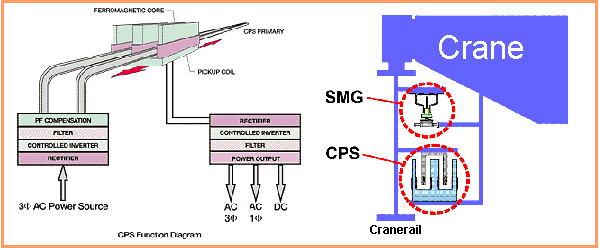Until now, large amounts of electrical power could only be transmitted by the familiar systems (contact rails, etc.). Now with the advent of the CPS system, this can be done by induction, ie. without contact. Capacities of up to several hundred kilowatt are feasible. VAHLE is certain that a 50 KW CPS system will be ready for series production in 1998. This is all based on results obtained at the Technical University of Brunswick, recognized as the leading research institute in electrical engineering. The university's institute for electric machines, drives and railways is an acknowledged trendsetter when it comes to researching inductive energy transmission. For more than twenty years, this renowned institution has been at the forefront of research in the field.
An expert partner
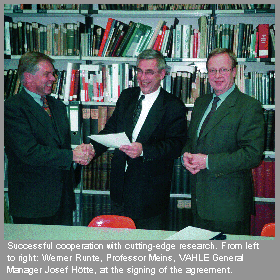 This is why VAHLE chose the
institute as its expert partner for basic research and development
on the CPS system. Working alongside engineers from Kamen, Professor
Jürgen Meins in Brunswick will take the future system for
contactless power supply through to the start of series production.
Werner Runte, technical manager at VAHLE and in charge of developing
the system describes the challenges that inductive power
transmission poses: "The system itself has existed for quite
some time. But it was used for relatively low levels of power. As
the electricity cannot be transmitted inductively easily, it
requires a special management. Transmitting larger amounts of energy
inductively wasn't economically viable, until the new power
electronics was available. Our mains electricity has a frequency of
50-60 hertz. For inductive transmission, I have to bring this up to
around 20,000 hertz. This is what makes contactless transmission of
greater power efficient."
This is why VAHLE chose the
institute as its expert partner for basic research and development
on the CPS system. Working alongside engineers from Kamen, Professor
Jürgen Meins in Brunswick will take the future system for
contactless power supply through to the start of series production.
Werner Runte, technical manager at VAHLE and in charge of developing
the system describes the challenges that inductive power
transmission poses: "The system itself has existed for quite
some time. But it was used for relatively low levels of power. As
the electricity cannot be transmitted inductively easily, it
requires a special management. Transmitting larger amounts of energy
inductively wasn't economically viable, until the new power
electronics was available. Our mains electricity has a frequency of
50-60 hertz. For inductive transmission, I have to bring this up to
around 20,000 hertz. This is what makes contactless transmission of
greater power efficient."
Beating limitations
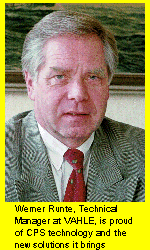 This brings solutions to a
whole range of power supply problems a lot closer. Werner Runte sees
the new system as a logical further development of the VAHLE
philosophy that "power supply must be managed optimally".
For one thing, we need fewer energy losses, and greater reliability
of contact. For another, we want to minimize wear and tear, and the
system has to function under adverse conditions, in an indoor system
or outside, with intense pollution or chemical effects. This is
where conventional power supplies come up against their limitations.
CPS beats those limitations. And Runte explains why: "CPS gives
power supplies high availability, and makes it independent of speed.
Because there is no contact, the VAHLE system has no wear and tear,
making it almost maintenance-free, and also emission-free. These are
requirements for power supplies in clean room production, for
example. In chip manufacture, pharmaceuticals, food production,
paintworks or similar - the solution is CPS. On top of this, the
system is noiseless. An with ist sensitivity to outside influences,
our system is perfect for use in tough environments such as harbours
or mines, or even in underwater tasks."
This brings solutions to a
whole range of power supply problems a lot closer. Werner Runte sees
the new system as a logical further development of the VAHLE
philosophy that "power supply must be managed optimally".
For one thing, we need fewer energy losses, and greater reliability
of contact. For another, we want to minimize wear and tear, and the
system has to function under adverse conditions, in an indoor system
or outside, with intense pollution or chemical effects. This is
where conventional power supplies come up against their limitations.
CPS beats those limitations. And Runte explains why: "CPS gives
power supplies high availability, and makes it independent of speed.
Because there is no contact, the VAHLE system has no wear and tear,
making it almost maintenance-free, and also emission-free. These are
requirements for power supplies in clean room production, for
example. In chip manufacture, pharmaceuticals, food production,
paintworks or similar - the solution is CPS. On top of this, the
system is noiseless. An with ist sensitivity to outside influences,
our system is perfect for use in tough environments such as harbours
or mines, or even in underwater tasks."
Future investments
Moreover, customers are demanding higher availability. A system has to function for years, with no failures. Compared with conventional systems, CPS technology has considerably longer maintenance intervals, and because there is no contact, a much longer life. These facts alone are clear arguments in favour of using the VAHLE system, but the conductor rail pioneer has more to add. Used in conjuction with the SMG system, CPS allows contactless transmission of energy and data (see diagrams). VAHLE has shown exactly how well this technology of the future works at the Hannover Fair.
Advantages of CPS
|
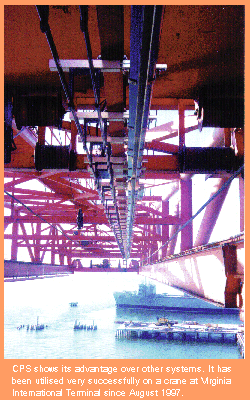 |
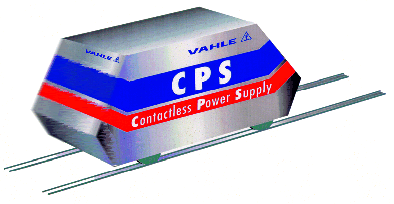 CPS: Safe, contactless, noiseless
CPS: Safe, contactless, noiseless
